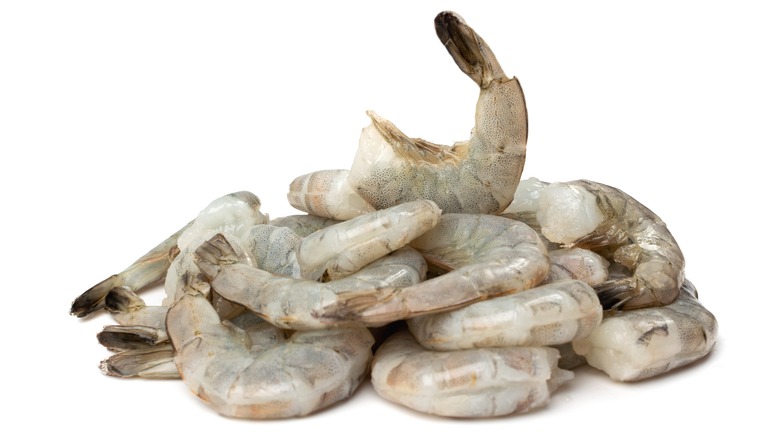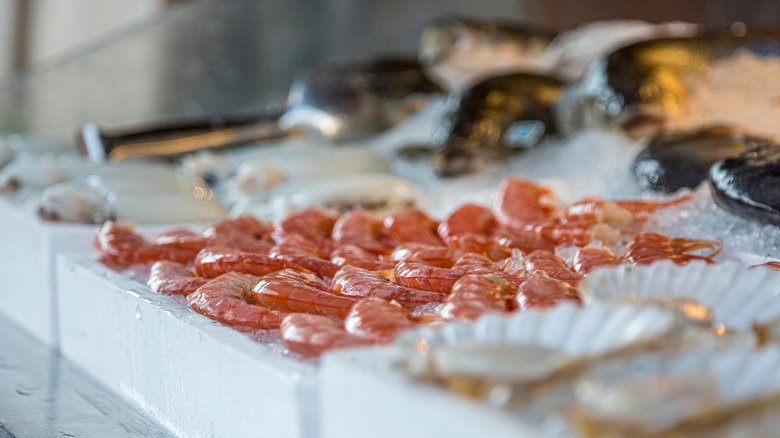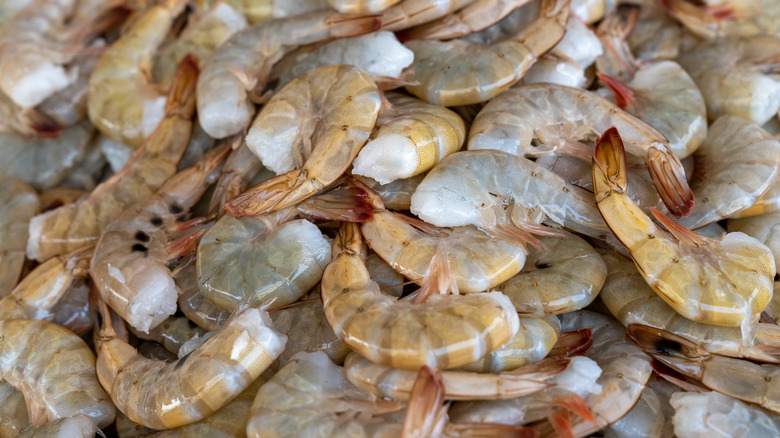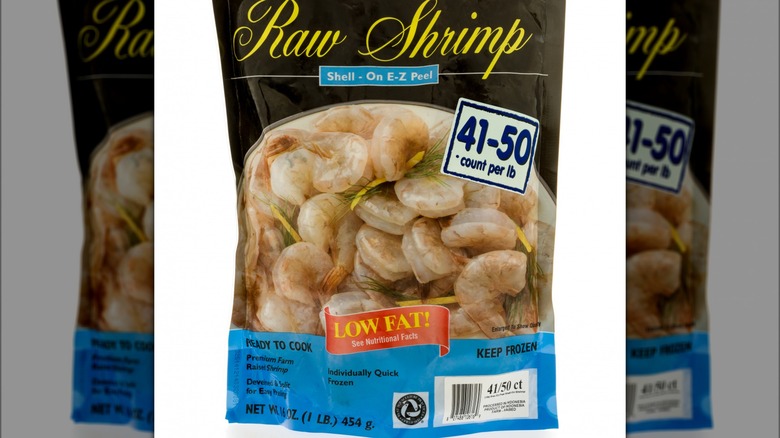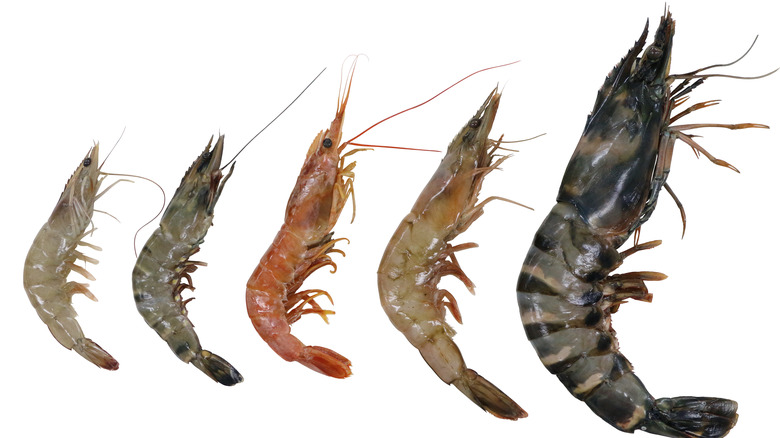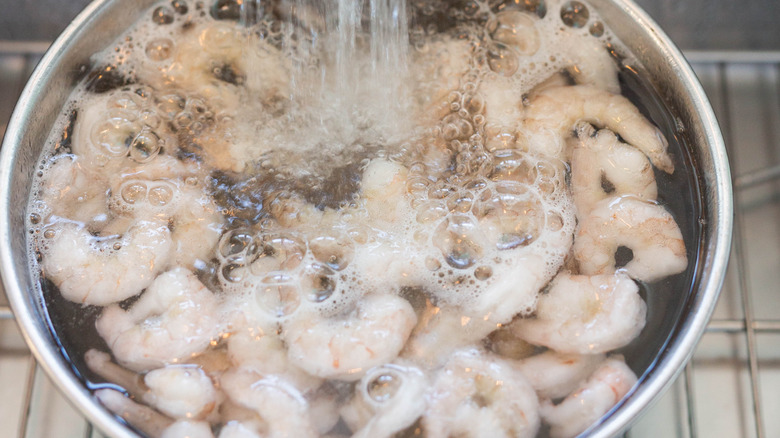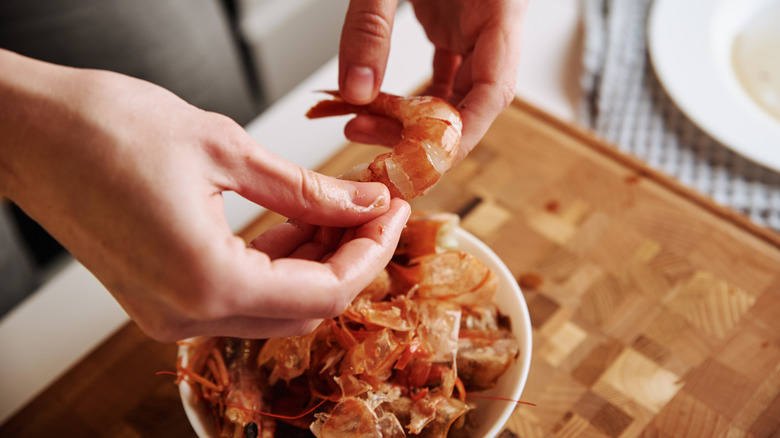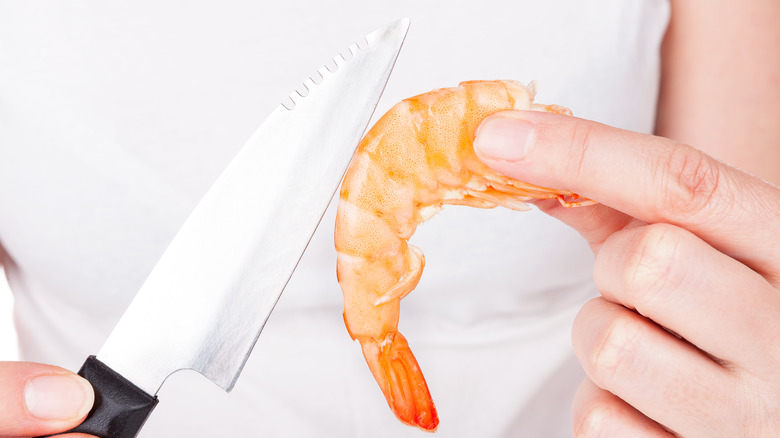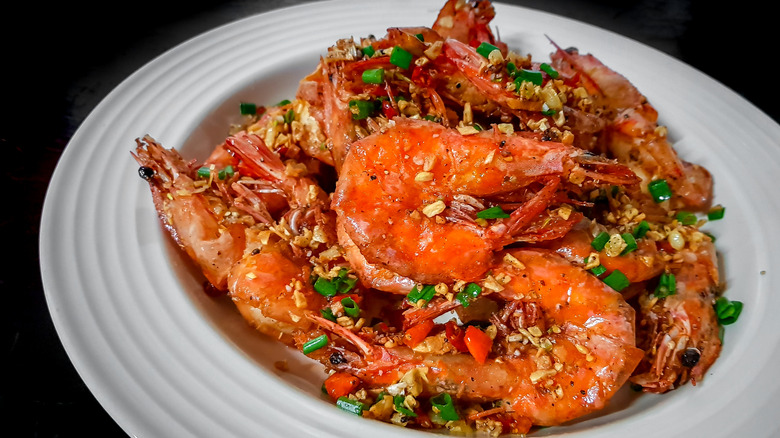How To Clean Store-Bought Frozen Shrimp
Quick cooking and versatile, shrimp is a favorite protein for a good reason. It can be served raw in ceviche, cooked with every method, and enjoyed hot or cold. Mid-twentieth-century homemakers even suspended it in colorful Jell-O molds for dinner parties.
Each three-ounce serving clocks in at only 84 calories, making this nutritious food source low in calories. Shrimp is a good source of omega-3 fatty acids, vitamins, and minerals, including iodine, which many people lack. When it comes to purchasing and cleaning the little crustacean, however, it can be a bit confusing. From the different sizes, farmed versus wild, and fresh versus frozen options, it helps to be on a first-name basis with your fishmonger.
Regardless of how the shrimp is prepared, it's usually headed, shelled, and deveined before enjoying. While you can pay a premium for fishmongers to do it, it's simple enough to do at home, saving a few bucks to splurge on pricy citrus. If you're looking to incorporate more fish into your diet, here's what you need to know about cleaning store-bought frozen shrimp.
Farmed versus wild-caught shrimp
The grocery store's ice cube-strewn seafood case is often labeled with fish that's been farmed or wild-caught. Americans eat, on average, almost six pounds of shrimp annually. Because it's so popular, 94% of the shrimp sold in the U.S. is imported from Southeast Asia, Ecuador, and Canada, where it is primarily farm-raised.
Although the Food and Drug Administration (FDA) prohibits using antibiotics for farm-raised shrimp in the U.S., other countries commonly use the drug to prevent disease. Since antibiotic-infected imports are at risk of making it into the U.S. food supply, concerned consumers should purchase wild-caught imported shrimp or domestically caught when they can find it.
Fresh versus frozen shrimp
Short of cooking live shrimp, purchasing it frozen is the best bet for the freshest quality. Shrimpers deep freeze their catch at sea, so the shrimp labeled as "fresh" at the market is previously frozen.
Rather than risk how long the thawed shrimp has been on display, buy a bag of frozen shrimp for a fraction of the price and defrost it safely at home. Purchase bags of frozen shrimp that do not have signs of being thawed and refrozen, like ice crystals. Packages labeled with a blue BAP-Certified stamp (Best Aquaculture Practices) indicate that the farmed shrimp is responsibly harvested and overseen by the Global Seafood Alliance.
Safely defrost shrimp in the refrigerator overnight. To expedite the process, submerge the airtight bag of frozen shrimp in a bowl of cold water until thawed. Avoid defrosting seafood and meat on the kitchen counter, where foodborne bacteria can multiply rapidly and cause illness. Defrosted shrimp should be cooked within two days.
Shell-on, E-Z peel, or peeled shrimp
Frozen shrimp is available at different price points, sold as shell-on, E-Z peel, or prepeeled. The less work you must do at home, the more it will cost. Fortunately, the less expensive shell-on shrimp is often of better quality than shelled shrimp, which is often overhandled. In addition, when preparing boiled shrimp, the shell adds flavor to the court boullion or fish stock.
E-Z peel shrimp are more expensive but easier to prep. The shells are split up the back, and the large intestine is often removed, intentionally or unintentionally. This is done by machine, so sometimes you need to return with a paring knife and finish the job, but more on that in a bit.
Prepeeled shrimp is the most expensive frozen option. The shell and the back vein are wholly removed. The shrimp are usually treated with an additive called sodium tripolyphosphate, which causes them to bloat. Although this is the pricier option, you have less control over the final presentation, so this may not be the best option if you are simply preparing the shrimp and serving them whole and naked.
Shrimp sizes
Determining how much shrimp to order can be confusing. Rather than focus on the arbitrary adjectives assigned by the sellers that aren't regulated, like jumbo or baby, consumers can identify the size by "U-10" or "10/13."
U.S. sold shrimp labeled "U-10" means there are 'under' ten pieces of shrimp per pound. When two numbers are separated by a dash or slash, like "10-13 or 10/13," it indicates that there are between 10 and 13 shrimp per pound. The lower the number, the bigger the shrimp. The bigger the shrimp, the more they cost. Generally, you can purchase shrimp from baby "U-50" to extra colossal "U-10."
Thankfully, baby shrimp are sold peeled and deveined. They are best used in dishes where they aren't the star ingredient, like stir-fries. Small shrimp are slightly larger, 36/45 per pound, and ideal for popcorn shrimp and shrimp boils.
If you want to highlight the shrimp in a scampi or risotto, select "U-31" or larger shrimp, like jumbo shrimp, which is 21/25 per pound. For an impressive shrimp cocktail or fried shrimp, choose meaty colossal shrimp, which range from U-13 to U-10. Stuffed shrimp are commonly this size.
Defrost the shrimp
Frozen shrimp should be defrosted before cleaning. Attempting to split the shell while the fish is still frozen is dangerous and can cause the knife to slip. Allow the shrimp to thaw thoroughly to clean out the vein, which is essentially shrimp poop. It won't make you sick if left in, but it should be removed for presentation and texture purposes since it may contain sand.
Look for IQF (individually quick frozen) shrimp versus block shrimp, which allows you to remove what you need and reseal the package. Block shrimp is frozen in a single, solid piece and will take longer to defrost.
Peel the shrimp
Once thawed, remove the shrimp's shell, but don't throw it out. Save the shells in an airtight container in the freezer to flavor stock. Shrimp can be cooked with the shell on, but removing the vein is easier if it's peeled. If the shrimp still has its head, pull or cut it off.
If the frozen shrimp has been machine cut, labeled "E-Z Peel," you can use your fingers to peel the shell from the back where it's been split and remove the legs. Shell-on shrimp can be split with a paring knife along the back, or the shell can be easily pried off by separating it between its legs. If the shrimp is thawed, the shell is removed easily.
Depending on the dish, you can leave the tail on to give people something to hold onto or remove it with the shell. If you detach the tail, don't miss the meat inside. Squeeze the tail with your thumb and forefinger to push the meat out.
Devein the shrimp
Shrimp can be deveined using a paring knife, toothpick, or an inexpensive deveiner with a curved, serrated blade. Cut along the shrimp's back from the tail to the head. If you prefer to cook the shrimp with the shell intact, use kitchen shears to cut along the back to split the shell and access the vein.
The digestive tract is shallow under the surface, so the cut must only be ¼-inch deep to expose the thin black vein. Use the knife tip or a toothpick to dig out the vein and discard it. It can cling to your finger or knife, so it may help to rinse the shrimp and the blade. Ensure the shrimp is dry before cooking your favorite recipes.
Delicious shrimp recipes
Try our salt and pepper shrimp stir-fry for a dish that checks all the boxes — crispy, spicy, tender, and delicious. This dish is traditionally prepared with a shell on it but can be made without it. Dusted with cornstarch, the cleaned shrimp are seasoned with green onions, garlic, ginger, chilis, salt, and black pepper for a recipe that's "just the right amount of heat." Serve the shrimp over rice or noodles for a crowd-pleasing meal.
Since shrimp takes only a few minutes to boil, preparing a flavorful court bouillon is essential to season the meat. Instead of cooking them in water, try using beer. Most varieties like lagers, citrus, or wheat beers will infuse the meat with so much flavor that you may not want to dip them in any cocktail sauce.
For a cozy meal, try this simple shrimp congee recipe. This dish has an umami-packed porridge made with ginger, garlic, scallions, and long-grain rice topped with sweet shrimp. This is comfort in a bowl.

